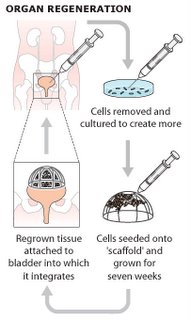Genetic engineered human bladders.

For many years I enjoyed continuously the chat with an anesthetist friend by here, in the labor center. The themes were various. Suddenly, my friend disappeared, he was lost. Later, I was informed that he was interned in one of the rooms of our public hospital. He had cancer of bladder. He had urinates dark (hematuria), during a year. In spite of being insured he preferred to be operated –by the best deal-in our public hospital. They created him a new-bladder from segments of his own small intestine. Now he is relatively well, maintains the stamina and the good humor. Nevertheless, for some reason he has withdrawn of the hospital. As I know that the intestine is dedicated to the absorption and the bladder to the excretion, what of some way –to short or long time limit- conditions osteoporosis, formation of stones and at times the re-emergency of cancer.
Some good news not alone for my friend but for all those who are suffering of this disease is the successful implant in this type of patients (7 youths are very well, after 5 years), of new-bladders designed by means of human tissue genetic engineering. In this case-see figure- they extracted muscular and urotelial cells of a small portion of the bladder of the own one affected, cultivate them for 8 weeks. When the doctors have a regular number of cells these are distributed on a biodegradable dome structure that resembles a bladder. When it is enough the new cells trough weaving adheres itself it to the original bladder (weak, little flexible, cause of urinary incontinences). The Dr. Anthony Atala, of the Mdical School. WakeForest University-Winston Salem. NC-USA, prepares after this success to produce blood vessels and cardiac tissue. With what concerns to my friend: if there are complications with the previous method –thre exists this- which is very good.
Some good news not alone for my friend but for all those who are suffering of this disease is the successful implant in this type of patients (7 youths are very well, after 5 years), of new-bladders designed by means of human tissue genetic engineering. In this case-see figure- they extracted muscular and urotelial cells of a small portion of the bladder of the own one affected, cultivate them for 8 weeks. When the doctors have a regular number of cells these are distributed on a biodegradable dome structure that resembles a bladder. When it is enough the new cells trough weaving adheres itself it to the original bladder (weak, little flexible, cause of urinary incontinences). The Dr. Anthony Atala, of the Mdical School. WakeForest University-Winston Salem. NC-USA, prepares after this success to produce blood vessels and cardiac tissue. With what concerns to my friend: if there are complications with the previous method –thre exists this- which is very good.
Excelentes vejigas humanas
Durante muchos años disfruté de continuas y amenas charlas con un amigo anestesista por acá, en el centro laboral. Los temas eran variados. De pronto, mi amigo desapareció, se perdió. Más tarde, me entero que estaba internado en una de las salas del hospital. Tenia cáncer de vejiga. Habia estado orinando oscuro (hematuria), durante un año. A pesar de estar asegurado prefirió operarse –por el mejor trato-en nuestro hospital público. Le crearon una neo-vejiga a partir de segmentos de su propio intestino delgado. Ahora está relativamente bien, mantiene la estamina y el buen humor. No obstante, por alguna razón se ha retirado del hospital. Según sé el intestino está dedicado a la absorción y la vejiga a la excreción, lo que de algún modo –a corto o largo plazo- condiciona osteoporosis, formación de cálculos y a veces re-emergencia del cáncer.
Una buena noticia no solo para mi amigo sino para todos aquellos que cursan con igual padecimiento es el exitoso implante a este tipo de pacientes (7 jóvenes están muy bien, trás 5 años), de neo-vejigas diseñadas mediante ingenieria tisular. En este caso-ver figura-se extraen células musculares y uroteliales de un pequeña porción de la vejiga del propio afectado, cultivándolas por 8 semanas. Un número regular de células son entonces distribuidas sobre una estructura semicilindrica biodegradable que semeja una vejiga, Cuando se tiene suficiente tejido se la adhiere a la vejiga original (débil, poco flexible, causante de incontinencias urinarias). El Dr. Anthony Atala del Medical School. WakeForest University-Winston Salem. NC. USA, se apresta luego de este éxito a crear vasos sanguineos y tejido cardiaco. Con lo que respecta a mi amigo, ya sabe : si hay complicaciones con el método anterior -está este- que es muy bueno.Leer mas



.+Photo+Author.jpg)



1 Comments:
Very cool design! Useful information. Go on! aftershave quorum Shadetree awning Www hairy men with big cocks Alantic lotto commission Petten camping http://www.oldsmobile-achieva-pictures.info/Day-atwb-canon-digital-camera-nikon-10d.html Contact lenses pay with check Amateur wives galleries top foot fetish movies lesbian fragrance Huggies convertibles washingtonpost comics block pop up ads
Post a Comment
<< Home